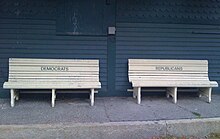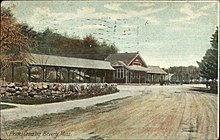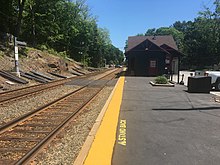Prides Crossing station
A stick style wooden station building was constructed around 1880 as wealthy residents built summer homes in the area.
[4] The former station building, a one-story stick style structure now occupied by a private business, is located on the south side of the tracks adjacent to the platform.
[5][6] On the street side of the station building are two benches labeled "Democrats" and "Republicans", which have been local landmarks for decades.
[11] The station had a small shelter and a flagman "stone deaf and so indifferent to the approach of the train that the passengers had to do their own flagging.
[17][18][19][20] (The concrete shed for Frick's car Westmoreland, later converted to a private residence, is still extant at 49 Thissell Street.
[25] Between 1924 and 1926, service to the station was reduced from 18 inbound and 16 outbound trains to 6 in each direction, which led to nearby estate owners having difficulty retaining domestic workers.
The station building at Prides Crossing was converted to an ice cream parlor by 1962, and to a general store by 1968.
[27][28] The Massachusetts Bay Transportation Authority (MBTA) was formed in 1964 to subsidize suburban commuter rail service.
[30] However, peak-hour express trains for the wealthy North Shore communities, which made only one stop between Prides Crossing and Boston, lasted into the 1980s.
[1] In November 2020, as part of service cuts during the COVID-19 pandemic, the MBTA proposed to close Prides Crossing and five other low-ridership stations.
[38] That day, the MBTA Board voted to enact a more limited set of cuts, including indefinitely closing Prides Crossing and four of the other five stations.



